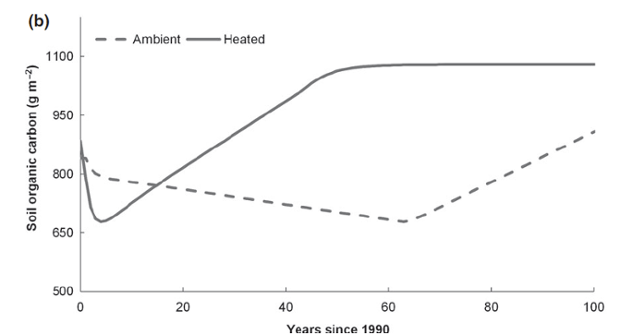
Earth Protect Blog
- Font size: Larger Smaller
- Hits: 2500
- 0 Comments
A 23-year experiment finds surprising global warming impacts

A new paper published in Global Change Biology summarizes the results of a 23-year experiment monitoring how global warming is impacting certain ecosystems.
At the Rocky Mountain Biological Laboratory, the scientists have monitored ten 30-square meter plots of meadowland since 1989. Above five of those plots, overhead infrared radiators have been on constantly since January 1991, while the other five were used as the controls for comparison. The study reports,
The microclimatic effect of experimental heating throughout the growing season has been to warm the top 15 cm of soil by ~2 °C and dry it by 10–20% (gravimetric basis) during the growing season, and to prolong the snow-free season at each end by an average of ~2 weeks.
Ecosystem Changes Amplifying Global Warming
The scientists monitored the type of vegetation growing in the meadows. In both the controlled and heated plots, they saw a shift away from flowering plants, towards woody plants like sagebrush, with a bigger change in the heated plots.
They also monitored the amount of carbon in the soil. In the heated plots, the amount of carbon stored in the soil decreased, but it later rebounded. In the control plots, the carbon storage decreased more slowly, and hasn’t yet rebounded after 23 years. Simulations suggest the soil carbon storage will continue to decline for about anther 40 years before it rebounds.
 100-year simulation of soil carbon storage in mountain grasslands and meadows. Photograph: Harte et al. (2015), Global Change Biology.
100-year simulation of soil carbon storage in mountain grasslands and meadows. Photograph: Harte et al. (2015), Global Change Biology.
The change in carbon storage was caused by the shift from flowering to woody plants. As lead author John Harte of UC Berkeley explained,
When shrubs replace forbs [flowering plants], the rate of input of organic carbon to the soil declines because in these ecosystems forbs photosynthesize at a higher rate (per area) than do the shrubs and return more annual growth to the soil at the end of the growing season. The loss of all that annual production leads to a rather rapid decline in soil carbon (the quantity factor). But the soil carbon arising from dead shrub leaves is less digestible than is the soil carbon from forbs (the quality factor).
Over a period of decades, this leads to the eventual recovery of the soil carbon. The delay in the influence of the quality factor is due to the fact that until the soil carbon resulting from shrub production has built up to a sufficient level, most of the soil carbon will still be that from forbs.
The study notes that a similar change happening as spruce forests convert to pine forests. This shift results in less carbon storage in both the short- and long-term, causing what’s called a “positive feedback,” as more carbon remaining in the atmosphere will amplify global warming further. I asked Dr. Harte if he could speculate about whether these results give us an indication about how we can expect carbon storage in the global biosphere to change in a hotter world. He told me,
A basis for speculation at the global scale comes from ice core data showing that over the past hundreds of thousands of years, during periods in which earth is warming, atmospheric CO2 levels rise, and during periods in which earth is cooling, those levels drop. The oceans undoubtedly play a big role in this but it is likely that terrestrial ecosystems also factor in. While we can’t yet be quantitative, there is good reason to believe that the terrestrial contribution is on average, one of positive feedback (that is, contributing to the global trend revealed in the ice core data).
Changes Happening Sooner than Expected
While some of the changes in the heated plots were expected, the scientists were surprised that they saw similar changes occur in the control plots. Since 1991, the snow-free season has become extended, the soil has become hotter and drier, and there’s been a shift from flowering to woody vegetation. Harte said of his research,
We were actually very surprised to see such dramatic changes in the control plots. That the plant community could undergo such rapid change, from a carpet of wildflowers to sagebrush, in just a couple of decades under the artificial heaters was not a surprise. But that the same transition would be visible in the ambient plots was a surprise; we expected that such a transition would take at least 3 or 4 decades.
And even more surprising was the clear evidence after two decades that the ambient plots were losing soil carbon to the atmosphere. A number of soil scientists said that it was a waste of time to measure soil carbon because we would never detect change in the lifetime of an experiment. Not only could we detect it rather rapidly in the heated plots, but it is now apparent even in the ambient plots.
Comments
-
Please login first in order for you to submit comments













